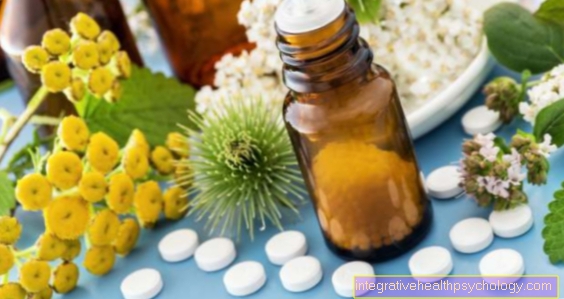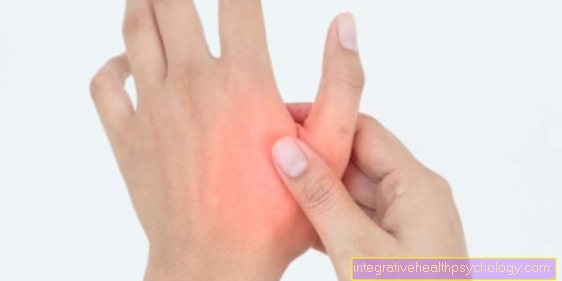Sinusitis
introduction
Sinusitis is inflammation of the lining of the sinuses, usually caused by viruses or bacteria. A distinction is made between acute and chronic sinusitis. The paranasal sinuses are air-filled cavities in the facial skull and are divided into the maxillary sinuses (Maxillary sinusitis, right next to the nose; the largest sinuses), the frontal sinuses (Frontal sinusitis, in the middle above the nose above the eyebrows), the ethmoid cells (Ethmoid sinusitis, between the nose and the inner corner of the eye) (see also: Inflammation of the ethmoid cells) and the sphenoid sinus. Acute suppuration usually affects the maxillary sinuses, but inflammation of the ethmoid cells or frontal sinuses can also occur. Sinusitis in the area of the sphenoid sinus is very rare. The inflammation of the nasal mucous membranes is usually associated with headache or facial pain, fever and general fatigue. The most common triggers of sinusitis are respiratory viruses, in around 20 percent of cases it is a bacterial infection, but other causes such as allergies are also possible. Acute viral sinusitis can be transmitted by droplet infection, for example when coughing or sneezing. Often there is also a growth of inflammatory polyps (mucous membrane protuberances) in the paranasal sinuses.
diagnosis
The diagnosis is made through various measures:
- the physical exam
- the taking of swabs from the nasal secretion to identify the bacterial pathogen
and - a nasoscopy (Rhinoscopy)
With complicated processes, such as An MRI of the paranasal sinuses can help with the transition to chronic sinusitis, treatment failure and the determination of an alternative diagnosis (med. differential diagnosis). However, an MRI for sinusitis is by no means a standard diagnostic tool. As an alternative to MRI, a CT (computer tomography) can also be used to establish the diagnosis.
Figure sinuses

- Frontal sinus -
Frontal sinus - Ethmoid cells -
Cellulae ethmoidales - Maxillary sinus -
Maxillary sinus - Sphenoid sinus -
Sphenoid sinus - Thin septum -
Septum sinuum frontalium
You can find an overview of all Dr-Gumpert images at: medical illustrations
therapy
A sinus infection (Sinusitis) is mostly caused by viruses or bacteria. Treatment for sinusitis is aimed at reducing inflammation of the lining of the nose and restoring the drainage of mucus from the sinuses. First and foremost, measures should be taken to Liquefaction of the mucus which improves the excretion of mucus. This is for example through increased fluid intake (e.g. drinking), but also a high level of humidity, Steam inhalations and Nasal irrigation or -have a shower Using isotonic saline solutions or seawater sprays can help relieve the symptoms of a sinus infection. Also can Decongestant nasal sprays or drops (e.g. active ingredient: xylometazoline, oxymetazoline) can be used. Expectorants can also be used to rid the sinuses of secretions. Various preparations are available without a prescription in pharmacies or drugstores, such as capsules with the active ingredient cineole, which has an expectorant and anti-inflammatory effect within a short time. The use of cortisonecontaining nasal sprays can help reduce inflammation. Over-the-counter pain relievers with active ingredients such as paracetamol or ibuprofen help against headaches and facial pain. Antibiotics may be appropriate if sinusitis with severe symptoms or if a bacterial infection has been identified. In some cases with severe disease, an operation may be necessary to facilitate the drainage of mucus (e.g. removal of polyps, straightening of the nasal septum). However, surgery is only necessary if drug treatment does not provide sufficient relief from the symptoms, since according to the current state of the art, optimal drug therapy is just as effective as surgery. Even in the case of chronic sinusitis, surgery is often not expected to completely resolve the symptoms.
The frequency and severity of the symptoms can be alleviated, but most of those affected must continue to receive therapeutic care even after an operation, since the symptoms recur in many cases after an operation. For example, nasal polyps that have been removed can grow back after a while.
A Sinus surgery always hides RisksFor example, important structures used to moisten the nose can be damaged during surgery, which is why it is common dry mucous membranes comes after the operation. In rare cases, structures near the sinuses can also be injured.
Since a chronic sinus infection can have many different causes, it must be decided on an individual basis what type of surgery can help alleviate the symptoms in each individual case. A reduction in size of the turbinate is rarely carried out today, the typical surgical measure nowadays is a so-called functional endoscopic operation of the paranasal sinuses (short: FESS). Constrictions or nasal polyps can be removed. This method is very gentle and hardly painful, usually only a day of hospitalization is required after the procedure. The nasal septum can also be operated on endoscopically. There is also the option of using laser technology to shrink swollen mucous membranes in the area of the paranasal sinuses. By reducing the swelling of the mucous membranes, one hopes for a milder course in phases of infection, since blockages in the area of the paranasal sinuses do not occur so quickly. In rather simple cases of chronic sinusitis, a so-called Balloon dilatation be performed. A balloon is inserted into the nose using a catheter and slowly inflated at the entrance to the paranasal sinuses, which allows narrow openings to be expanded. This method is relative easy and with few complications linked, however, it is questionable whether this surgery has any long-term benefit.
Drug therapy for sinusitis
Various medications can be used to relieve the symptoms of sinus infections. Sinusitis is often accompanied by headache, facial pain, or toothache. These symptoms can be effectively relieved with over-the-counter pain relievers containing active ingredients such as paracetamol or ibuprofen. Decongestant nasal sprays or drops (active ingredients: xylomethazoline, oxymetazoline) are very often used in acute sinus infections to relieve the swelling of the mucous membranes, as well as to enable normal discharge of secretion and adequate ventilation of the sinuses. If the sinusitis is caused by an allergic disease, nasal sprays or drops based on antihistamines and glucocorticoids (cortisone) are used. However, it should be noted that the nasal mucous membranes can be permanently damaged by nasal sprays and a kind of dependency can develop with prolonged use. Various medications can be used to liquefy nasal secretions and to make them easier to drain. Active ingredients such as ambroxol come into question here. Naturopathy also offers some medicines to treat sinus infections. Schüssler salts, homeopathic remedies, but also the ingredients of plants (e.g. myrtol, eucalyptus oil, elderflower, chamomile, cineole) can help to alleviate the symptoms of sinusitis. For example, Sinupret®, available as Sinupret® forte or Sinupret® drops, is used as a herbal preparation.
In various types of application, these agents can have an expectorant effect and bring relief from acute sinus infections. Antibiotics are rarely indicated in sinusitis. For example, an antibiotic with the active ingredient amoxicilin should only be taken if the symptoms of the sinusitis are very severe, persist for more than a week, or if a bacterial cause for the sinus infection has been determined.
Antibiotic therapy for sinusitis
In the treatment of sinusitis, the use of antibiotics is extremely seldom necessary, as both bacterial and viral infections heal within fourteen days without complications in 60 to 80 percent of cases. Even so, acute sinus infection is one of the most common reasons for prescribing antibiotics. Antibiotic therapy is only indicated in the case of severe symptoms or impending complications. Certain symptoms suggest bacterial sinusitis such as high fever, one-sided severe Facial pain, Swelling around the eyes, sensitivity to light, stiff neck, or if symptoms last more than seven days. In this case, antibiotics are recommended. In cases where antibiotics are indicated, the active ingredient amoxicillin is particularly recommended. A sinus infection is most common from Respiratory viruses triggered. In these cases antibiotics have little or no effect. Treatment without antibiotics, aimed at reducing the swelling of the mucous membranes and enabling normal discharge of secretions and adequate ventilation of the sinuses, is sufficient in most cases to alleviate the symptoms of sinusitis and accelerate the healing process.
Home remedies for sinusitis
There are several home remedies that can be used to treat sinus infections by clearing mucus from the sinuses and making breathing easier. As soon as the first symptoms appear, it is advisable to tackle the symptoms with simple home remedies. For example, it makes sense to inhale warm fumesto let the irritated mucous membranes swell and clear the nose of mucus. To do this, fill boiling water (possibly with the addition of essential oils, Eucalyptus oil or chamomile blossoms) into a bowl, bend over this with a towel over your head and inhale the rising steam. Just inhaling two or three times a day for a few minutes can alleviate the symptoms of a cold or sinus infection. Caution should be exercised with essential oils in infants and children as they can irritate the airways and trigger an asthma attack, which can cause an infant or child to experience difficulty breathing. A cold bath at body temperature can also help clear the sinuses.
Not only the Warmth of the fumes can be beneficial, too Infrared lightdirected at the sinuses can speed up the healing process. However, the use of heat only makes sense if it is perceived as pleasant. In the case of very severe inflammation, the symptoms can be aggravated by heat. They are suitable for rinsing the sinuses Saline solutionsthat you can either buy ready-made at the pharmacy or make yourself. There are so-called Nasal showersthat you can use for this, but you can also put the rinsing solution in a small bowl. Then you cover your nostril and suck up water with the free nostril. The solution flows through the nose and comes out through the mouth. Rinsing the paranasal sinuses makes it easier to snort off the secretion and the salt water also has a disinfecting effect. The sinuses should not be rinsed more than four times a day. However, you should not overdo it with measures to clear the sinuses, as the mucous membranes can be irritated quickly and nosebleeds can occur.
Other home remedies for sinus treatment are Envelopes. A linen towel or washcloth is put in warm water and Eucalyptus oil or lemon and then placed on the sinuses. A very important home remedy for sinus infections is high fluid intake to liquefy the mucus. Herbal and peppermint teas can also have a decongestant effect. In addition, care should be taken to ensure that the humidity in the living rooms is sufficient and that cigarette smoke is avoided in the area, as it irritates the mucous membranes.
If sinus infection symptoms do not improve despite using home remedies, a doctor should be consulted so that the disease can be completely cured and a chronic course can be prevented.
Duration of sinusitis
Acute sinusitis usually heals within a few days to weeks. Depending on the duration, there are two types of sinus infections.
One speaks of chronic sinusitis if the symptoms persist for more than 2 to 3 months. Chronic sinusitis usually results from acute sinusitis that has not healed and often affects the maxillary sinuses and ethmoid cells. Long-lasting loss of smell (Anosmia), chronic, watery runny nose, constant, dull pressure over the paranasal sinuses and flow of secretions into the throat are common symptoms of chronic sinusitis. Chronic sinusitis is favored by permanent constrictions in the sinuses, nasal polyps, special pathogens or a weakened immune system.
Read more on the topic: Superinfection

